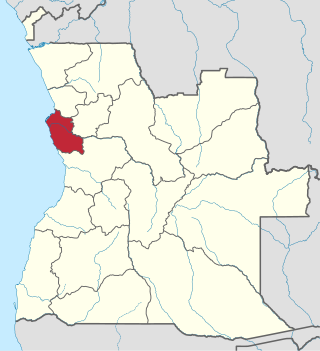
Bengo is a province of Angola. Its capital is Caxito. It has an area of 31,371 square kilometres, and its population as of the 2014 Census was 356,641. The province was created in 1980 by dividing the original province of Luanda into Bengo and a new smaller province of Luanda.

The Cuanza Norte Province is province of Angola. N'dalatando is the capital and the province has an area of 24,110 km2 and a population of 443,386. Manuel Pedro Pacavira was born here and is a former provincial governor. The 1,400 meter long Capanda Dam is located in this province. Cuanza Norte lies on the northern bank of the Cuanza River. It had been a territory of Ngola Kingdom. In 1914, Norton de Matos created District of Cuanza which was divided into Cuanza Norte and Cuanza Sul Provinces in 1917.

Luanda is a province of Angola. It covers an area of 18,835 km2, and had a population of 6,945,386 at the Census of 16 May 2014. The latest official estimate is 9,079,811.

The Kingdom of Ndongo was an early-modern African state located in the highlands between the Lukala and Kwanza Rivers, in what is now Angola.

The Ambundu or Mbundu (Mbundu: Ambundu or Akwambundu, singular: Mumbundu are a Bantu people who live on a high plateau in present-day Angola just north of the Kwanza River. The Ambundu speak Kimbundu, and most also speak the official language of the country, Portuguese. They are the second biggest ethnic group in the country and make up 25% of the total population of Angola.
The precolonial history of Angola lasted until Portugal annexed the territory as a colony in 1655.
The colonial history of Angola is usually considered to run from the appearance of the Portuguese under Diogo Cão in 1482 (Congo) or 1484 until the independence of Angola in November 1975. Settlement did not begin until Novais's establishment of São Paulo de Loanda (Luanda) in 1575, however, and the Portuguese government only formally incorporated Angola as a colony in 1655 or on May 12, 1886.

Loango-Angola is the name for the possessions of the Dutch West India Company in contemporary Angola and the Republic of the Congo. Notably, the name refers to the colony that was captured from the Portuguese between 1641 and 1648. Due to the distance between Luanda and Elmina, the capital of the Dutch Gold Coast, a separate administration for the southern districts of Africa was established at Luanda during the period of the Dutch occupation.

The following outline is provided as an overview of and topical guide to Angola:
The Fortress of São Francisco do Penedo is located in the port city of Luanda, Angola.
The Church of Our Lady of Victoria stands near the banks of the Cuanza River in Massanganu, Province of Kwanza-Norte, Angola.
The Fortress of Kambambe is a historic stronghold built by Portuguese colonialists on the east bank of the Cuanza River in Cambambe, Province of Cuanza Norte Province, Angola.

The Church of Our lady of Muxima is located in the Muxima District of Bengo Province, western Angola.
The Little Fort of Kikombo is located in the town of Kikombo on the Atlantic coast of Angola, where Rio Kikombo reaches the ocean, in the province of Kwanza-sul.
The Church of Nossa Senhora do Rosario is located in Kuanza Norte province, Angola.

Muxima is a town and commune in the municipality of Quiçama, Luanda Province, Angola. The village, located by Kwanza river, was occupied in 1589 by the Portuguese who erected a church and a fortress in 1599. Muxima means "heart" in Kimbundu. It is the site of a Marian shrine. The town is the home of the 16th century Portuguese Fortress of Muxima.
The Portuguese colony of Angola was founded in 1575 with the arrival of Paulo Dias de Novais with a hundred families of colonists and four hundred soldiers. Luanda was granted the status of city in 1605. The fortified Portuguese towns of Luanda and Benguela.

Quiçama, Quissama or Kisama is one of the nine municípios that make up the province of Luanda, as per the new administrative division of the province . It covers an area of 13,900 square kilometres (5,400 sq mi) and its population as of 2014 is 26,546. The municipal seat is the village of Muxima.
The Bengo is a river in northern Angola with a source in the Crystal Mountains. Its mouth is at the Atlantic Ocean 20 kilometres (12 mi) north of Luanda in Bengo Province. The river is 300 kilometres (190 mi) long with a drainage area of 7,370 square kilometres (2,850 sq mi). There is a large reservoir called Kiminha on the Bengo. There are several small lakes on the lower 90 kilometres (56 mi) of the river floodplain including Lakes Panguila, Quilunda and Lalama. The Bengo River floodplain is the main source of the agricultural produce for Luanda. Drinking water from the Bengo River was transported to Luanda in barrels by boat before an aqueduct was built in 1889. Trucks deliver much of the city's modern water supply, loaded by pumps in the river.

The Fort Nossa Senhora da Vitória de Massangano, popularly known as Fortress of Massangano is located in the village-commune of Massangano, in the municipality of Cambambe, in the province of Cuanza-Norte, in Angola.










